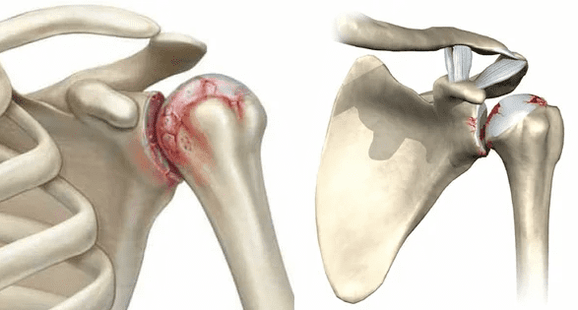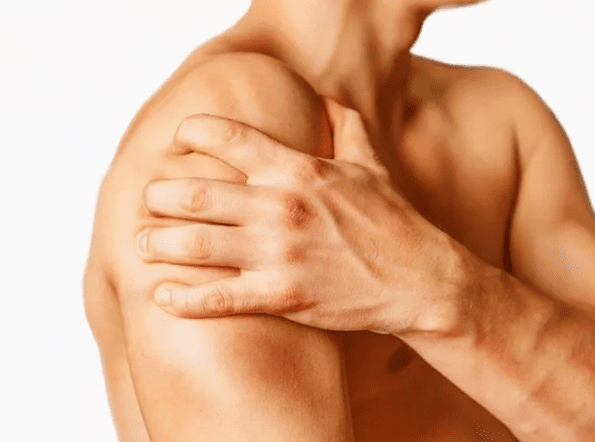Osteoarthritis of the shoulder joint is a chronic disease that is based on damage to cartilage tissue, followed by the appearance of bone growths and limited mobility. Most often the elderly suffer, but hard physical work and inflammatory processes contribute to the early development of the pathology. Without timely treatment, movements in the affected joint are completely blocked.

Main information
Cartilage is a smooth layer between the contact areas of the bones. It ensures that they slide easily against each other, ensuring free and painless collaboration. Excessive stress, inflammation or trauma can cause a degenerative process that gradually spreads over the entire surface.
As a result, the smoothness of the joint surfaces is disturbed and the movements begin to cause pain. At the same time, bone growths begin to appear at the edges of the joint, replacing the affected cartilage. As the degenerative process progresses, it involves not only the bones but also the surrounding tissues. The limb deforms, the muscles spasm, and the ligaments become weak and lose elasticity. Without treatment, a person loses the ability to move the arm.
Views
Depending on the cause of development, primary and secondary arthrosis are distinguished. The primary form occurs on its own, most often against the background of excessive overload of the joint. The secondary is provoked by pathology of a third party, such as trauma, intense inflammation, metabolic disorders, etc. Both forms of the disease are similar in symptoms.
The reasons
Unlike the knee, ankle and hip joints, the shoulder does not experience significant walking stress, which is why this form of osteoarthritis is much less common. The pathology can be caused by:
- regular excessive physical activity: weight lifting, professional sports, vibration;
- congenital anomalies of the structure of the shoulder joint and adjacent structures;
- rheumatoid arthritis, systemic lupus erythematosus and other autoimmune diseases;
- congenital weakness of the connective tissue, accompanied by hypermobility of the joints;
- injuries: sprains, sprains and tears of tendons, intra-articular bone fractures;
- hormonal changes and disorders (including pregnancy, menopause);
- inflammatory diseases of the joint and periarticular structures (arthritis, bursitis, etc. );
- metabolic disorders, including gout, diabetes mellitus.
Heredity plays an important role in the predisposition to osteoarthritis.
Degrees
Doctors identify 3 degrees of deforming arthrosis of the shoulder joint, which determine its symptoms and the choice of treatment tactics:
- Grade 1 is characterized by minimal manifestations: the pain occurs only with intense or prolonged exercise and passes quickly after rest, and X-ray reveals subchondral sclerosis of the joint surfaces;
- in osteoarthritis of the 2nd degree the pain becomes much stronger, one should use painkillers to feel better; radiography shows marked narrowing of the joint space, extensive areas of cartilage destruction, as well as bone growths (osteophytes);
- Grade 3 disease is accompanied by constant intense pain, joint mobility is significantly limited and the picture shows complete destruction of cartilage, deformation of bone structures and a large number of osteophytes.
Symptoms
The main symptoms of osteoarthritis of the shoulder include:
- pain: arises from a decrease in the smoothness of the joint surfaces, the growth of osteophytes and bone deformation; the intensity, duration and nature of the sensations depend on the degree of damage;
- cartilage: one of the characteristic symptoms of the disease, appearing in the early stages; differs from the physiological with a rougher tone and, moreover, is often accompanied by pain;
- restriction of mobility: associated with the appearance of pathological growths and particles of destroyed cartilage inside the joint; in the first stages it is presented with a slight morning stiffness, later it grows to complete immobility (ankylosis);
- deformation: a change in the contours first only of the joint and then of the hand, occurs in the late stages of the disease and shows the complete destruction of cartilage and the involvement of bones, muscles and ligaments in the pathological process.
The progression of symptoms can take years or even decades, but eventually osteoarthritis of the shoulder joint leads to inability to move the arm and severe pain.

Diagnosis
The diagnosis of osteoarthritis of the shoulder joint requires an integrated approach. To accurately diagnose and determine the extent of the lesion, the doctor uses the following methods:
- interrogation and collection of anamnesis: the patient's complaints are recorded, the circumstances of the appearance of certain symptoms are determined; the information about past illnesses and injuries, the presence of joint injuries in the parents must be clarified;
- examination: the doctor makes a visual assessment of the joint, determines the range of motion, the area of greatest pain, etc. ;
- X-ray and CT: the main diagnostic method that allows you to see the characteristic symptoms of osteoarthritis (narrowing of the joint space, cartilage degeneration, bone growth and deformities);
- Ultrasound: allows you to assess the condition of cartilage, bones, tendons, joint capsule and muscles;
- MRI: allows you to get virtual slices from all structures of the affected area;
- laboratory diagnosis: a blood test reveals an active inflammatory process, often accompanying osteoarthritis;
- arthroscopy: examination of the inside of the joint with a camera placed through a small puncture.
If the disease is secondary, examinations and consultations with narrow specialists in the underlying pathology are mandatory.
Treatment of shoulder osteoarthritis
The treatment of osteoarthritis of the shoulder joint depends on the extent of the lesion: in stages 1 and 2, the disease can be successfully stopped or delayed by the right selection of drugs. In case of extensive destruction, the only way to restore mobility and completely stop the pain is surgery - arthroscopy with "cleaning" of the joint.
Medication treatment
Medical treatment for shoulder osteoarthritis is aimed at reducing symptoms and restoring cartilage tissue. The following groups of drugs are used for this:
- non-steroidal anti-inflammatory drugs: block inflammatory reactions and reduce pain; available in the form of tablets, ointments, suppositories and in the form of injections;
- hormonal agents (corticosteroids): used when NSAIDs are ineffective, have a similar effect; good effect is provided by drugs with prolonged action, injected directly into the joint cavity;
- antispasmodics, B vitamins: used to reduce muscle spasm, which inevitably accompanies advanced osteoarthritis;
- chondroprotectors: designed for long-term use, aimed at restoring cartilage tissue;
- drugs that improve microcirculation: indirectly stimulate regeneration processes by improving the blood supply to the affected area;
- enzyme blockers: partially slow down the destruction of cartilage tissue.
The choice of specific drugs, their dose, frequency of administration and duration of the course is made only by a doctor! It is important to remember that self-medication can cause accelerated joint degeneration and other side effects.
Physiotherapy
Physiotherapy techniques and physiotherapy exercises significantly facilitate the course of the disease and enhance the effect of drugs. The following procedures have been shown to have a good effect:
- magnetic therapy: relieves pain, relieves inflammation, improves microcirculation and stimulates the regeneration of cartilage tissue;
- shock wave therapy: exposure to acoustic waves with a certain frequency contributes to the destruction of osteophytes, which facilitates movement in the affected joint;
- electrophoresis, phonophoresis: the introduction of drugs (painkillers, chondroprotectors) into the tissues by means of electrical impulses or ultrasound; encourages better absorption of medicines;
- massage and physiotherapy exercises: dosed loads on the joint and intensive manual action stimulate blood circulation in the tissues.
Like medication, physiotherapy, massage and exercise should be prescribed and performed under the supervision of a specialist. If in a quiet period they are beneficial, then the effect on the background of an acute inflammatory process can cause increased pain.
Surgery
The last stage of shoulder osteoarthritis is accompanied by severe symptoms and requires surgical treatment. Most changes that occur as a result of degeneration are irreversible, so the only way to restore a person's mobility is endoprosthesis. The affected joint is replaced with a modern prosthesis, which fully assumes its functions. This operation is especially effective at a young and middle age, as it allows you to live without pain for years.
Prevention
Like any joint disease, shoulder osteoarthritis is easier to prevent than to treat. Orthopedists recommend following the following rules:
- eliminate or minimize occupational risk factors (vibration, weight lifting);
- not to allow hypodynamics, but also not to strive for sports records: it is better to choose a moderate training option;
- control diet and weight;
- undergo regular checkups to identify possible problems.
Diet
In shoulder osteoarthritis of any degree it is important to monitor nutrition:
- avoid overeating and being overweight;
- minimize harmful products: fatty, spicy, salty, alcohol, canned, smoked meats;
- eat enough foods high in collagen (jelly, aspic) and omega-3 (oily fish, olive oil);
- give preference to cooked, steamed or stewed food, rather than fried;
- reduce the amount of digestible carbohydrates.
The diet should be complete and include the necessary amount of vitamins, minerals and nutrients.
Consequences and complications
Even mild pain and crunch in the shoulder can turn into unpleasant consequences. Without treatment, osteoarthritis leads to:
- significant restriction of mobility to ankylosis (bone fusion);
- severe pain even at rest;
- severe deformity of the shoulder and the whole arm.
To avoid these problems, it is important not to search the Internet for how to treat osteoarthritis of the shoulder joint with folk remedies, but simply contact an orthopedist for the choice of therapy.
Treatment in a specialized clinic
It is impossible to cure osteoarthritis alone. The specialists of the modern clinic offer patients complex methods for treatment of shoulder arthrosis:
- modern drug therapy regimens that combine high efficacy and minimal side effects;
- time-tested and new physiotherapeutic techniques;
- PRP therapy;
- physiotherapy exercises and massage to relieve the restriction of joint movements.
If necessary, medical punctures of the joint are performed with the introduction of painkillers or artificial synovial fluid, which facilitates movement.
We monitor the patient during treatment to keep the disease under control.
Advantages of modern clinics
Specialized blades offer their patients:
- comprehensive health screening programs;
- advanced research for accurate diagnosis;
- consultations of narrow specialists from different profiles;
- modern treatment schemes, including not only drugs, but also physiotherapy, massage and exercise;
- reasonable prices for all services.
Osteoarthritis of the shoulder is a problem that can completely change a person's life. Do not allow the disease to pass into an irreversible stage, come in consultation with an orthopedist.



































